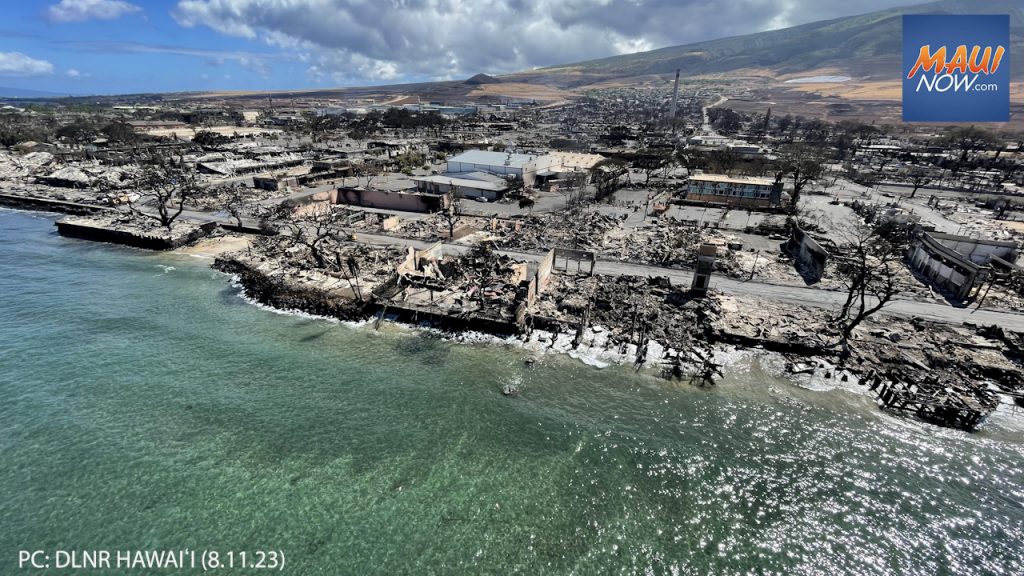Maui Council panel advances bill to expedite rebuilding of wildfire survivors’ properties

Six months after the Aug. 8 Maui wildfire disaster, the Maui County Council’s Water and Infrastructure Committee recommended passage Thursday of a bill to lower building permit review hurdles and allow fire survivors to rebuild sooner rather than later.
However, before construction can start, it’s expected to take years for the removal of fire ash and debris and for repairs and rebuilding of devastated infrastructure, like water and sewer systems, and electrical grids.
Bill 21 advances to the full Council for first reading, possibly on Feb. 28.
Department of Public Works Director Jordan Molina told committee members Thursday morning that the bill would modify an existing emergency permit procedure to include wildfire-impacted properties.
Disaster-affected applications will be flagged for staff reviewing permits, he said. “They will not get co-mingled with the regular stack of permits that we’re working through.”
Also, applications for electrical and plumbing permits will be consolidated into a single application for more expeditious review, Molina said.
The bill also has an approval-by-default provision, he said.
“If we do not get our review done within 15 days, the applicant can demand issuance” of the permit, Molina said. “So it’s incumbent on the applicant to press that issue when the time comes, and we’ll respond accordingly.”
He stressed that the measure affects permit processing procedures and not the standards that agencies enforce as part of the permit review process. Also, applicants who need a special management permit will still need that, Molina added. It remains under discussion whether Public Works officials will accept a building permit application to begin processing it before all SMA issues are resolved.
The county is in the process of hiring a consultant to assist with what’s expected to be a large increase in building permit applications after construction is cleared to begin, Molina said. A Public Works Department request for proposals received five responses from consultants, and “right now we’re working through making the final selections.” Final selection will be followed by drafting a contract for three years of services, with work beginning in April.

Council Member Gabe Johnson asked whether three years would be sufficient given the massive scope of the Lahaina disaster.
“It seems it is just a monumental task,” he said.
Molina said the pace of processing building permits will depend on property owners and their individual circumstances. Different scenarios for fire-impacted property owners include some who’ve already left Maui; others who are uninsured; and second homeowners who may not have an urgent need to rebuild as soon as possible.
“Generally speaking, the anticipation is that those guys that are ready, had enough insurance and want to come back, we’ll hit within the first one to two years,” he said. “And, that’s going to be kind of your big surge.”
The committee’s action comes as displaced West Maui residents remain in temporary housing while permanent options for shelter are difficult to find on island. During a press conference Thursday, Gov. Josh Green reported that 4,961 fire survivors, or 2,089 households, continue to stay in 17 hotels.
“Our goal is to swiftly move individuals into long-term housing,” he said.
Green said 2,367 long-term rentals have been secured to house people, but another 500 units are needed to house wildfire survivors, “but we are well on track to secure housing for our people.”
The measure to expedite emergency permits opens a four-year window for rebuilding on disaster-impacted parcels under a modified permit application that, for residential structures, may consolidate Department of Public Works’ electrical, plumbing, driveway, grading and other permits. Permits for commercial structures will get priority treatment, but they may not be consolidated into a modified application unless authorized by a county building official.
Also, in further time savings for modified emergency permits, the building official may review and approve the modified applications without sending such applications to other reviewing departments, except when there’s a determination that such a review is necessary. Also, the building official must obtain comments and concurrence from appropriate reviewing departments for emergency applications that involve a commercial structure or causes a lot to contain more than two dwellings.
Permit fees may be deferred for plan reviews for residential structures, but not for commercial buildings. The permit fee may be reduced by half for the reconstruction of recently built residential structures or commercial structures using previously approved construction plans.
When fire survivors will be able to rebuild depends on a several factors, including:
- The removal of ash and debris, estimated at 400,000 cubic yards or enough material to fill five football fields five-stories high. (This is ongoing with the US Army Corps of Engineers, which has completed removal from Kula properties and is working in Lahaina.)
- Properties will need to be served by functioning water, wastewater and electric grid systems, repaired roadways and other infrastructure — much of which was destroyed by the fire.
- Building permit applicants will need construction plans, and it could take time to prepare new drawings. Recently approved structures can use prior plans but older structures may not have such plans available.
- Whether other government approvals will be needed such as an SMA permit, flood development or historic district permits.

The committee vote to advance Bill 21 was 7-0 in favor, with Council Chair Alice Lee and Council Member Yuki Lei Sugimura excused. Council Member Tom Cook chairs the Water and Infrastructure Committee.









